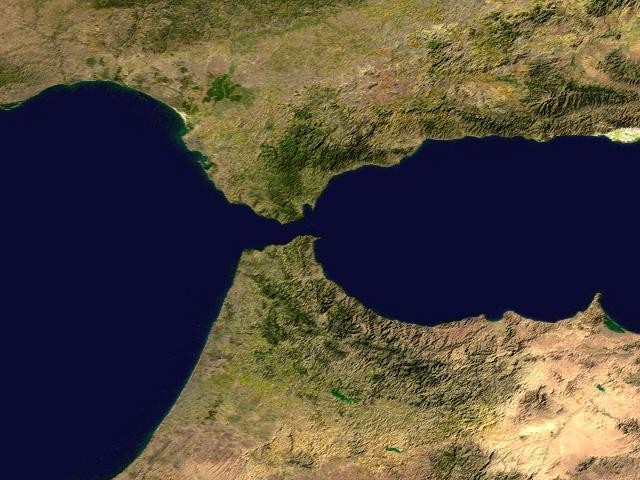strait
A STRAIT IS A narrow waterway connecting two larger bodies of water. These narrow passageways are sometimes the only way to travel from one body of water to another. They have been important to humans throughout history. Some of the most important straits include Bering Strait, Cook Strait, the Strait of GIBRALTAR and the Bosporus.
The Bering Strait is located between the easternmost point of Asia and the westernmost point of North America and connects the ARCTIC OCEAN and the Bering Sea. It measures about 55 mi (90 km) in width and ranges from 98 to 164 ft (30 to 50 m) deep. The strait is named for a Danish-born Russian explorer Vitus Bering, who crossed it in 1728. Two islands, Big Diomede and Little Diomede, lie in the middle of the strait. During the last Ice Age, ALASKA and SIBERIA were connected by a land bridge where the strait is now. Many archaeologists believe that some of the ancestors of today's Native Americans crossed this land bridge from Asia about 13,000 years ago. Later, the level of the sea rose, covering the land bridge and creating the Bering Strait.

Another well-known strait, the Bosporus, separates the European and Asian parts of TURKEY. It connects the BLACK SEA with the Sea of Marmara. The strait is about 20 mi (30 km) long and 2,100 ft (640 m) wide at the narrowest point. The Bosporus has always been important for the defense of the city of Istanbul, so castles were built on either side of the strait. Anadolu Hisar was built in 1390 on the Asian side, and Rumeli Hisar in 1452 on the European side. Two bridges now span the strait. One of them, the Bosporus Bridge, is one of the world's longest suspension bridges, at 3,254 ft (1074 m) long. It opened in 1973. A second bridge was completed in 1988. The Bosporus has been called the world's most dangerous strait. Huge oil tankers use the strait, which is three times busier than the Suez Canal. The strait is very narrow and twists and turns for 29 km (18 mi). Besides tankers, 2,500 commuter ferries a day travel the strait, plus fishing and pleasure boats.
Another dangerous strait is the Cook Strait, separating the North and South Islands of NEW ZEALAND. It was named for Captain James Cook, who discovered it in 1770 when he viewed it from a hill on Arapawa Island. The Maori name for the strait is Ruakawa, meaning “bitter water.” The strait is nearly 16 mi (26 km) across at the narrowest point, and 90 mi (145 km) at the widest point. It is 420 ft (128 m) deep. The shores on either side are lined with steep cliffs, and the South Island cliffs have deep bays. Navigation of the strait is treacherous, because of dangerous currents and fierce storms. A submarine cable, laid in 1866, carries electricity from the South to the North Island. The worst shipping disaster in the strait occurred in 1909 when the interisland ferry Penguin struck a rock and sunk. Only 30 of 105 people survived. The most recent disaster was the sinking of the Wahine in April 1968, after it struck Barrett's Reef during a storm.
Another important strait, the Strait of Gibraltar, is the only natural connection between the ATLANTIC OCEAN and the MEDITERRANEAN SEA. It is well known for the Barbary Apes, who live on the Rock of Gibraltar. SPAIN and Gibraltar lie to the north in Europe, and MOROCCO and Ceuta are on the south side in Africa. The strait is about 984 ft (300 m) deep, about 37 mi (60 km) long, and about 8 mi (13 km) wide. The Strait of Gibraltar is strategically located, since ships that travel from the Atlantic to the Mediterranean must pass through it. Every year about 80,000 commercial freighters use the strait. The strait is also home to several types of dolphins and whales.